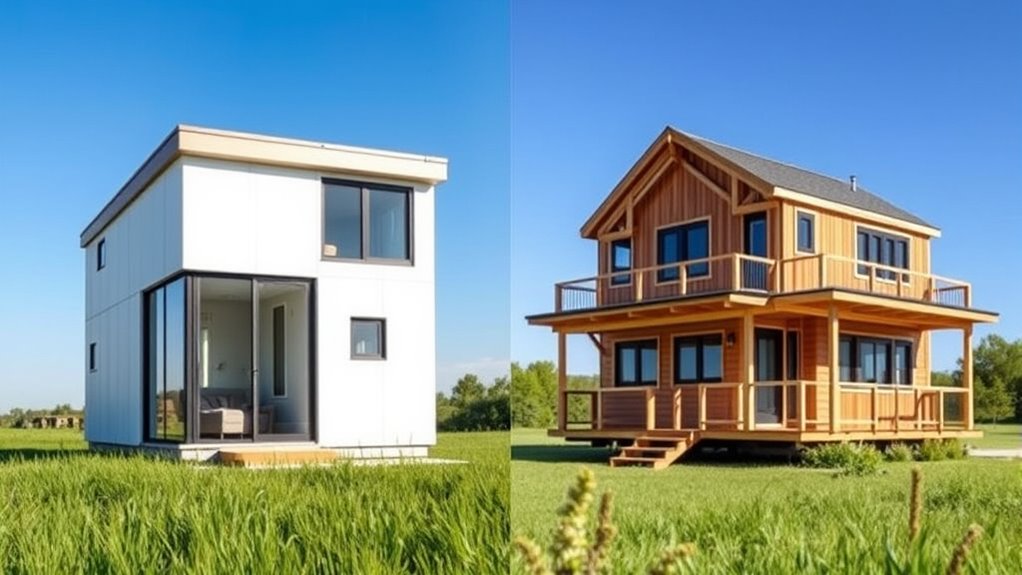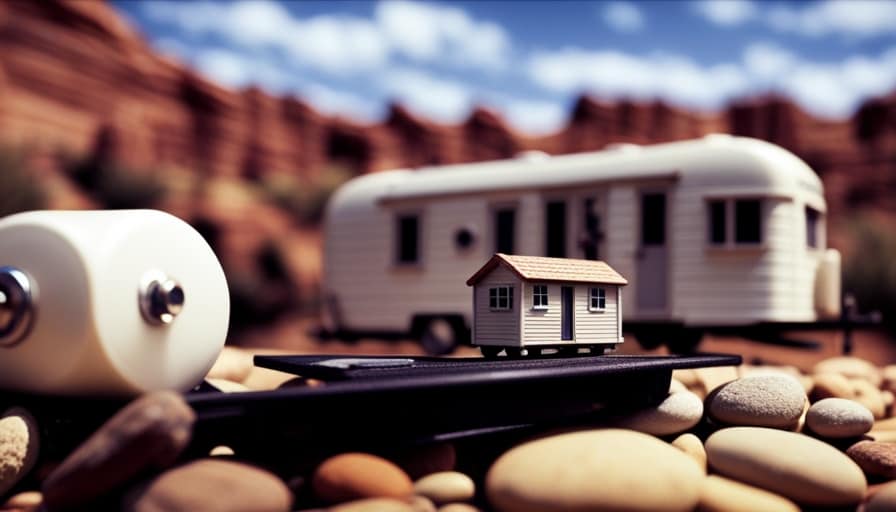Modular tiny houses are built in sections at a factory and assembled on-site, offering more customization and easier future expansion. Prefab tiny houses are pre-made and assembled from standardized components, making them simpler and quicker to set up but less flexible for modifications. If you want a home that grows with your needs, modular is a better choice. To understand which option suits you best, keep exploring the details below.
Key Takeaways
- Modular tiny houses offer greater customization and expandability compared to more standardized prefab models.
- Prefab tiny houses typically have quicker, streamlined production due to pre-made components.
- Modular homes are more adaptable for future modifications and additions, while prefab designs are more fixed.
- Both options promote sustainability, but modular houses often allow for more eco-friendly, flexible materials.
- Cost, maintenance, and repair ease can vary; prefab homes may be simpler initially, while modular homes support future upgrades.

When choosing a tiny house, understanding the differences between modular and prefab options can help you make an informed decision. Both styles offer quick, efficient construction, but they serve different needs and preferences. One key factor to think about is the sustainability benefits each option provides. Modular tiny houses are often built with sustainability in mind because they can be constructed in controlled environments, reducing waste and energy use during manufacturing. Many modular manufacturers incorporate eco-friendly materials, solar options, and energy-efficient appliances, making these homes a greener choice overall. Prefab tiny houses, on the other hand, are assembled from pre-made components, which can also be designed with sustainability in mind. Since they’re built in factories, they benefit from streamlined production that minimizes waste and often uses recycled or sustainable materials. Your choice depends on how much you prioritize environmental impact, as both options can be environmentally conscious if you select the right manufacturer. Additionally, the quality of repairs and maintenance services available for these tiny homes can influence their durability and longevity over time.
Modular and prefab tiny houses both promote sustainability through eco-friendly materials and efficient manufacturing processes.
Design flexibility is another essential aspect where these options differ. Modular tiny houses typically allow for a greater range of customization because they are built in sections that can be combined in various configurations. This means you can tailor the layout, add special features, or adapt the design to your specific needs more easily. If you envision a tiny home with multiple rooms, a loft, or unique architectural elements, modular construction might be the better fit. Prefab tiny houses tend to come in more standardized designs, which can limit customization. However, many prefab manufacturers now offer a variety of models and optional upgrades, so you can still personalize your space to some extent. If simplicity and cost-effectiveness are more important to you, prefab might be the way to go.
Both options are designed for efficiency, but modular homes often provide more flexibility for future expansion or modifications. Since they are built in sections, you can potentially add more modules down the line if your needs change. Prefab homes are usually more fixed in design, making modifications more complicated once assembled. When weighing these options, think about your long-term plans for the tiny house—whether you want the ability to customize and expand or prefer a straightforward, ready-to-move-in solution. Moreover, understanding the cost-effective services available in your area can help you budget for maintenance and repairs, ensuring your tiny home remains functional and efficient over the years.
Ultimately, your decision should align with your priorities: if sustainability benefits and design flexibility matter most, modular tiny homes may serve you better. If you lean toward simplicity and quick deployment, prefab options could suit your needs. By understanding these differences, you’ll be better equipped to choose a tiny home that matches your lifestyle, budget, and future plans.
Frequently Asked Questions
What Are the Environmental Impacts of Modular Versus Prefab Tiny Houses?
You’ll find that modular tiny houses often have a lower environmental impact because they use sustainable materials and are built with energy efficiency in mind. Prefab tiny houses also reduce waste and construction time, but may not always prioritize eco-friendly materials as much. Overall, both options can be environmentally friendly if they incorporate sustainable materials and focus on energy efficiency, helping you minimize your carbon footprint and promote greener living.
How Do Customization Options Differ Between Modular and Prefab Designs?
You’re in the driver’s seat when it comes to customization options, and the choice between modular and prefab tiny houses depends on your needs. Modular designs typically offer more flexibility for interior finishes, allowing you to tailor every detail. Prefab models often have limited exterior customization options, but they still let you choose finishes and colors. Keep in mind, with modular, you can usually adapt both interior and exterior features more easily.
What Are the Long-Term Maintenance Costs for Each Type?
You’ll find that the long-term maintenance costs for modular tiny houses are generally lower due to their durable construction and quality materials, which reduce repair needs. Prefab tiny houses might incur higher costs over time because of potential wear on less robust components. When considering the cost comparison, durability factors play a key role; investing in well-built modules can save you money on repairs and upkeep in the long run.
Can Modular or Prefab Tiny Houses Be Expanded Easily Later?
Yes, both modular and prefab tiny houses can be expanded later, but modular designs generally offer more expandability options. You can easily add sections or rooms for future modifications, making them flexible to your evolving needs. Prefab tiny houses might require more effort for expansion, often involving reconfiguration or additional modules. Consider your long-term plans and choose a design that best suits your desire for future modifications.
Are There Specific Zoning Laws Affecting Modular or Prefab Tiny Homes?
They say “know before you go,” and that’s especially true for tiny homes. Zoning restrictions and building codes can vary widely depending on your location, affecting modular and prefab tiny houses. Some areas may have strict regulations, while others are more flexible. You’ll need to check local zoning laws to guarantee your tiny home complies with all codes, so you avoid surprises and build with confidence.
Conclusion
Whether you choose modular or prefab tiny houses, you’re making a smart move toward simpler, more efficient living. Modular homes often feel like building a dream with endless customization, while prefab houses offer quick, affordable solutions. Whichever you pick, rest assured you’re transforming your life faster than you can say “tiny house revolution.” So go ahead—embrace the future of housing—because tiny homes are not just a trend, they’re the absolute game-changer of the century!









